MSI B85M ECO Review: Aiming Green at $73
by Ian Cutress on November 26, 2014 8:00 AM EST- Posted in
- Motherboards
- MSI
- B85
- ECO
MSI B85M ECO BIOS
If the Green Lantern (or perhaps Captain Planet) had a BIOS made especially for him, it would look something like the one MSI has equipped the B85M ECO with. If you have not had enough of the green theme, here it is in spades. The good thing for MSI is that the general BIOS layout is conducive to different color implementations, such as yellow for OC Certified and red for Gaming. Each of these gets a giant central logo, and here we get the ECO series version with a leaf being cupped by two hands.
Along the top ribbon is our usual fare of MSI data: Motherboard name, BIOS version, CPU installed, CPU speed, DRAM frequency, DRAM size, temperatures and boot order. As this is a B85 motherboard, the only real data missing here is perhaps the CPU fan speed, in case a dumb user (like I did) forgot to plug a CPU fan in at first.
On the top left is our ECO button which mimics the physical button on the motherboard as well as the ECO setting in software. This is where we normally see the XMP button on the main consumer line of motherboards.
In our six tabs we get two changes from normal – OC options become ECO and the OC Profiles become ECO Profiles. While the latter stays the same (saving the BIOS state to reload later), the ECO options gets the bulk of the BIOS changes.
However the first tab is the Settings options and anyone familiar with MSI BIOSes will not find anything out of place here. The first menu item, System Status, gives details on the BIOS and SATA ports connected:
The Advanced option in the Settings tab is more of the meaty part of the BIOS, giving configuration options for almost all of the onboard controllers.
There is not much here out of the ordinary. This motherboard supports Hot Plug on the SATA ports, although it is disabled via the Integrated Peripherals menu by default in order to speed up POST time and reduce power consumption when not in use.
Rapid Start is disabled by default, but Smart Connect is enabled as some of MSI’s OS software uses it incase the user wants to use it. The BIOS also includes Windows 8/8.1 fast booting features as well as Secure Boot and Wake Up events.
Users wanting to shave some more time from the POST, if they have full UEFI enabled hardware, can disable legacy boot options from the boot menu. Options such as Boot Override are found in the Save and Exit menu.
The real interesting new stuff in the BIOS comes in the ECO tab, where the first options allow the user to determine how the ECO button is controlled and if XMP should be enabled. As a side note, while we get XMP options, there are no sub-timing menus should users wish to optimize their memory manually.
In the Cut Power menu option we are able to disable various LEDs and fan headers from system POST. This is a cut down version of the options we get in the OS, but it is interesting to consider that MSI does not allow users to undervolt their CPU. As a system that is focused on saving power, for those users that know what they are doing, undervolting into a more efficient power band might save even more power. We asked MSI about this, and have published the response in the conclusion.
The ECO tab also gives details on CPU functionality and tech, although users might want to migrate to the CPU Features option to organize their power limits or C-states.
The M-Flash tab allows users to update the BIOS via a USB stick, and the ECO Profiles tab as mentioned above lets the user to save the BIOS for a future time or to share with others. I find this a bit odd – no user is going to dabble with profiles saving a few hundred milliwatts here and there depending on their usage that day, let alone share it with friends.
MSI’s interactive hardware monitor / fan controls are here. These appeared a little while ago now and even though there is not complete fine grain control over the settings, it does give an opportunity for MSI to show exactly what a BIOS can do when you focus more on user experience than pure functionality.
To finish up, we also get Board Explorer to help diagnose POST issues. The B85M ECO also has a favorites menu although the usage of such a menu in this type of product is not something I predict many (if any) users taking advantage of.


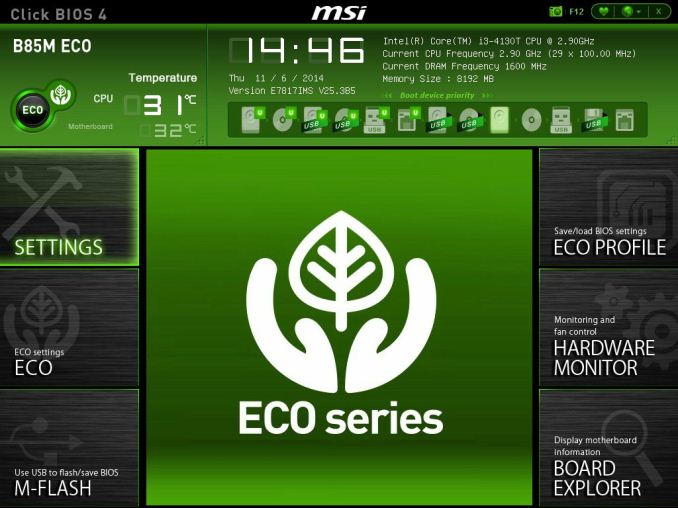
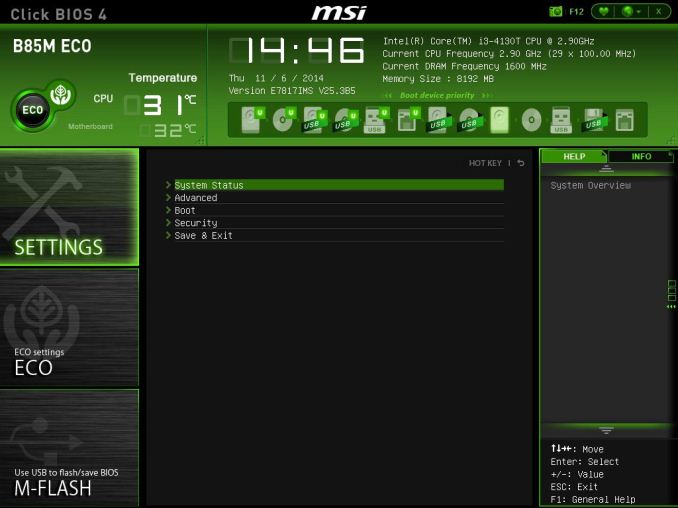
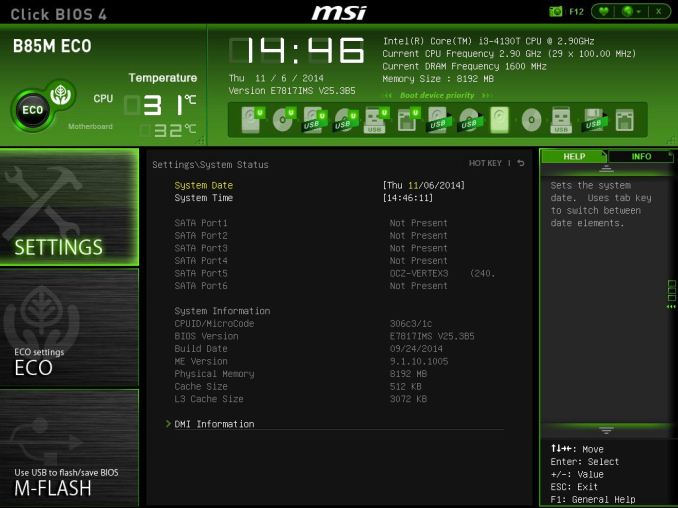

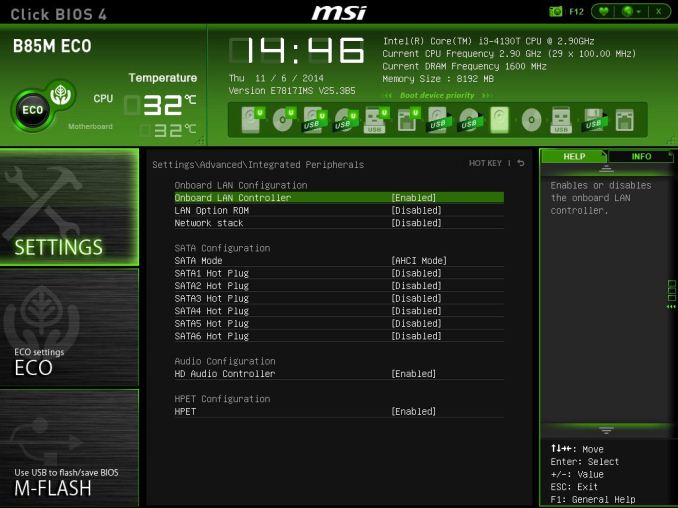

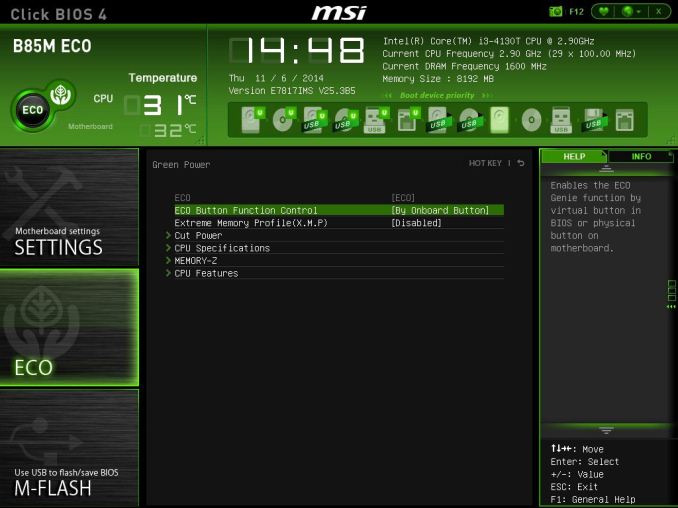
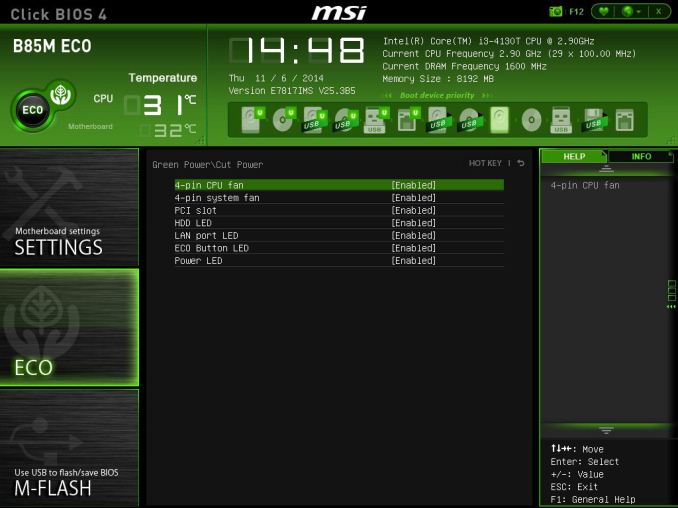
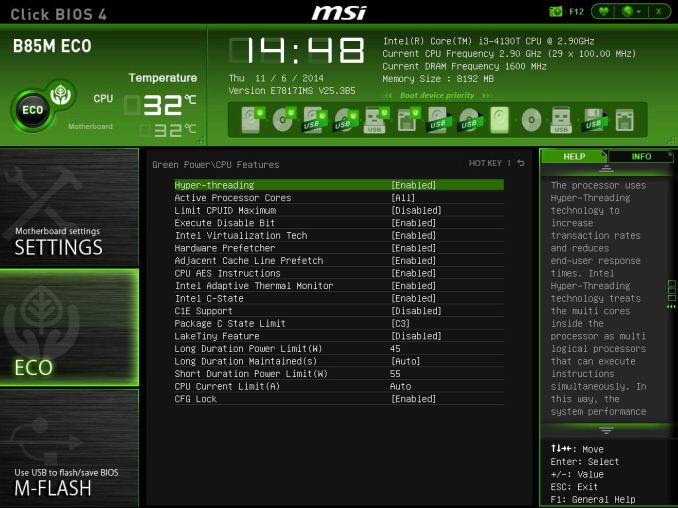
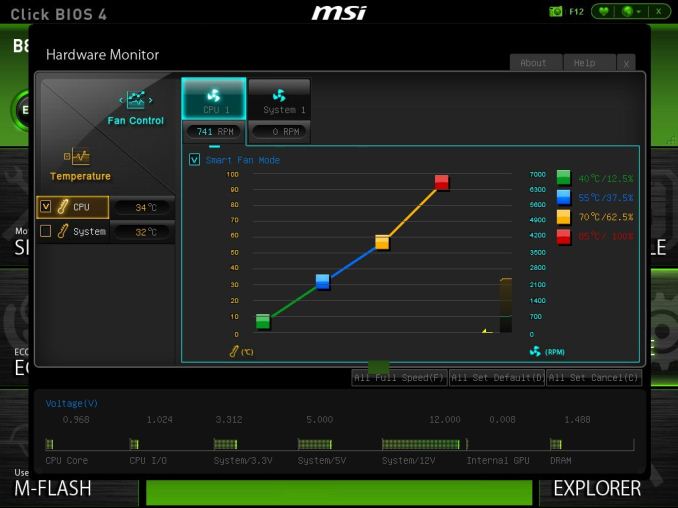















40 Comments
View All Comments
simonpschmitt - Wednesday, November 26, 2014 - link
I just found the board online for 68€ witch means one would break even after 2.2 Years.miksmi - Wednesday, November 26, 2014 - link
For servers, I moved to the mini-ITX form factor and am interested in an ECO version. I keep servers 8-10 years.hojnikb - Wednesday, November 26, 2014 - link
For office (and other non demanding uses) wouldn't it make more sense to go j1900 route rather than eco 1150 + celeron/pentium/i3 cpu ?It will use way less power than 1150 + fanless by default (even more power savings).
Ian Cutress - Wednesday, November 26, 2014 - link
For most office work, you're probably right. But a socketed platform does offer a potential upgrade path if the dynamics of the work change to something more computationally intensive. Also going down the LGA1150 route offers faster response times, which some businesses might argue is important when continuously dealing with emails and so on. It really depends on the scenario.Folterknecht - Wednesday, November 26, 2014 - link
"One of the points in the review was the inability to select a lower CPU voltage. Both voltage and frequency have a role in total system power consumption, but when full performance is still needed, voltage is the only variable left to modify. I posed this question to MSI, and received the following response:“We actually did try to do some testing with lower CPU voltage settings. The reason why we didn’t include it into the current BIOS is because we think Intel’s current FIVR architecture puts too many limits inside their design and we [would] rather use Intel’s integrated power saving features like C-State (Up to C7) and also SVID power. But it’s still a good suggestion that we can request our R&D to do more testing and check if we can fine tune better settings to enhance the power saving ability.”"
Lazy excuse in my book, considering that its still possible to undervolt current generation Intel CPUs quite a bit, at least when it comes to load voltage susually something between 0.1 - 0.2 V. As a MB manufacturer I can imagine that it would even be possible to play around with everything between idle and full load voltage, something a normal user cant do.
So instead of waisting their time on hot marketing air, develop something along the lines of auto-OC software or as an option in BIOS, but instead of overclocking let it undervolt the CPU automatically until it fails. But please no "1-2-3 click ready nonsense" of predefined values, more along the lines of a small stress test, which lowers the voltage by 0.02V or something like that after every sucessfull pass.
The perfect end result would be a bios voltage table (or in software), which fits the cpu installed - we all know the silicon lottery here. In an approach like this, lies much potential for saving energy.
andychow - Wednesday, November 26, 2014 - link
I've worked in the cubicles of many large corporations, and most people just log off their session or lock their screens at the end of the day, they don't turn the computer off. So cost savings would be even more interesting in these scenarios.piasabird - Wednesday, November 26, 2014 - link
So do unused ports and slots use power? Like if you use just 2 ddr3 SLOTS do the empty slots use power? Same with SATA and PCIE? So if the case is so why not use a MITX motherboard?piasabird - Wednesday, November 26, 2014 - link
You cant just look at the cost to run the motherboard. What about an eco friendly Monitor? Then there is the heat that is created to use the motherboard. During the summer or in say a server room something is cooling off the hot air.just4U - Wednesday, November 26, 2014 - link
Hi Ian,I hadn't really noticed that Anand wasn't reviewing business class motherboards. I picked up a H97 GAMING 3 MSI board for my wife a few weeks back.. certainly doesn't look like a business board.. but it does come with all the software. Maybe you will get a chance to review that one in coming months..
Anyway, on this one I almost thought it was a Sniper board at first geez.. GREEN.. Waiting to see your matx x99 review.. should be interesting!
Daniel Egger - Wednesday, November 26, 2014 - link
I LOLed when seeing the TÜV Logos. There're only few certifications like GS that follow a normed procedure. Other than that you can basically specify the test procedure and criteria, deliver the products (and a boatload of cash) and they will certify you that your products passed test procedures by the criteria you've specified. Very useful...The important point of information I'm missing here is: What were the tests? What were the passing criteria? Is there any competition which underwent the same certification and if so what were the results?